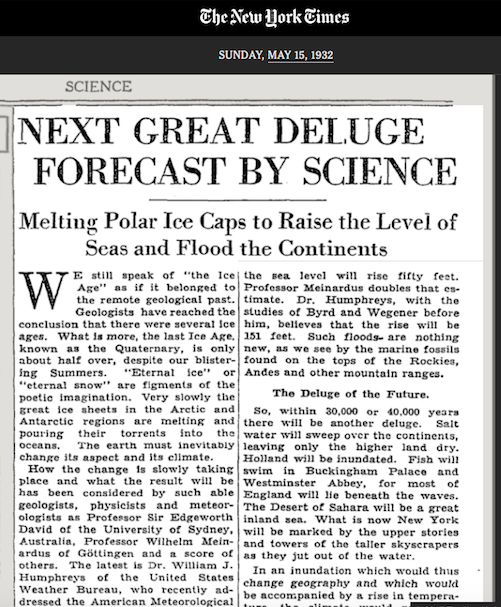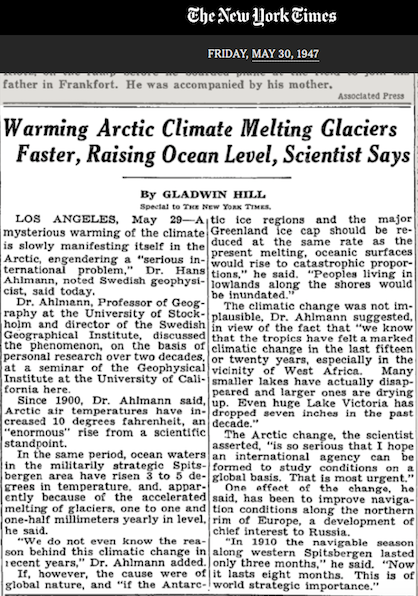Content originally published at iBankCoin.com
I will not pretend to be a scientist in this blog, or even claim to know the very first thing about global warming or lack thereof. I am more interested in human narratives, how they are woven, and the basis from which they were formed. Just like in stocks, when listening to an analyst, I like to know the historical performance of his/her previous picks.
Now that we have a vert active hurricane season again, all of the self-made climatologists are out shilling for their global agendas. It’s all very convenient, reminiscent of sudden calls for gun control following a mass murder.
Doing a cursory search of the NY Times archives, I found several articles warning Americans of the perils of global warming, several dating back to the early 1930s.
In the article below, dated May 15th, 1932, the NY Times cites scientific research that said the center of Greenland was ~9,000 ft thick and the edges ~4,000.

Today, according to a report out by experts…
…1,000m or 3,200 ft around the edges and 2,500m at the center or 8,200ft, roughly a 10% reduction from 75 years ago. Bear in mind, the instruments used to measure the thickness of the ice was rudimentary at best, back in 1932, so there must be some margin for error. Having said that, given the frantic panic, this is hardly a rate of change worthy of panic.
Here are some other articles from yesteryear.
Circa 1933, NY Times
Lastly, back in 1984, there were some skeptics — those who called out the global warming panickers of the 1960s and instead claimed that that ice sheets were instead getting ticker.
EXPERTS QUESTION SEA-RISE THEORY
Specialists in polar ice caps have expressed doubts about a rise in sea level that has been predicted as a consequence of the expected warming of world climates.
Some experts, in fact, now suspect that the sea level may fall.
Two reports on probable climate change were issued last October, one by the National Academy of Sciences and the other by the Environmental Protection Agency. Both suggested there would be substantial rises in worldwide sea levels if, as suspected, there was a rise of several degrees in global temperatures.
Such a rise would be caused by the effects of carbon dioxide delivered to the atmosphere by steadily increasing combustion of fuels. That gas absorbs infrared heat radiation from the earth instead of allowing it to escape into space, acting somewhat like the glass in a greenhouse.
Scientists at the environmental agency suggested that heating of polar latitudes would melt enough ice to raise sea levels four to seven feet by the year 2100. The academy report said a less radical rise of two feet was ”likely” in the next century, but added, ”More rapid rates could occur subsequently if the West Antarctic ice sheet should begin to disintegrate.” Forecasts Are Challenged
These predictions were challenged last week at the latest in a series of seminars on global habitability being held at Columbia University. It brought together Government and academic specialists to discuss the future of the Antarctic ice sheet.
In the past there have been far more ominous predictions regarding that ice sheet than those suggested in last October’s reports. In 1964 it was proposed that virtually the entire ice cap at the bottom of the world sometimes slips into the sea, raising global sea levels more than 200 feet, enough to flood many coastal lands and cities.
Such dramatic predictions fell out of fashion, and attention focused on the ice covering West Antarctica, that part of the continent south of the Americas. As pointed out at the Columbia seminar by Dr. George H. Denton of the University of Maine, an authority on the ice of West Antarctica, much of it rests on land thousands of feet below sea level.
Because such ice readily breaks off into icebergs it is thought to be more vulnerable to discharge than continental ice. Since it is a mile or more thick, its entry into the oceans would raise sea levels several feet.
It has been widely assumed that, between the last two ice ages, some 125,000 years ago, the climate was hotter than it is now and sea levels were 10 or 20 feet higher. Coral reefs formed in that period on some oceanic islands suggest such a high stand of the sea. These two lines of evidence were taken to mean that the West Antarctic ice dispersed into the oceans in that period. Past Assumptions Are Questioned
New evidence, however, questions both arguments, Dr. Denton said. While sea floor sediment in the North Atlantic suggests it was unusually warm there, it is beginning to appear the climate of the Southern Hemisphere was much like that of today. The coral reefs may be high, he added, not because the oceans were high but because the islands have risen.
Likewise the response to greater warmth is difficult to predict, Dr. Denton said. More moisture may be carried to the Antarctic hinterland, increasing snowfall there and the Antarctic ice ”may even expand,” he said.
The Antarctica’s interior is so high and cold there is virtually no melting and some scientists believe there would not be much, even if the climate warms. The critical area is along the coasts, where ice discharges as icebergs.
As pointed out by Dr. Arnold Gordon of Columbia’s Lamont-Doherty Geological Observatory, the behavior of the ocean along the coast may be a controlling influence. A change in oceanic circulation in response to warming of the atmosphere could, for example, alter the extent to which deep water wells upward along the rim of Antarctica and beneath its coastal ice shelves.
The two shelves through which most West Antarctic ice reaches the sea are considered keys to the fate of that region’s ice cover. They are the Ross Ice Shelf on the Pacific side and the Filchner and Ronne ice shelves facing the Weddell Sea on the Atlantic side. Each shelf is fed by broad ice streams flowing from the hinterland.
The shelves are thought to hold back the flow of ice and there has therefore been concern that they might be unstable. As stated by Dr. Robert H. Thomas, manager of the polar oceans program of the National Aeronautics and Space Administration, the conclusion seems ”unambiguous” that, if the shelves go to sea, the ice of West Antarctica ”will collapse.”
The seaward edge of the shelves breaks off into icebergs. Should this process accelerate, specialists believe it could drain much of the ice from West Antarctica in a matter of centuries. Hence, in the last few years, there have been extensive studies of the ice cover.
Dr. Ian M. Whillans of the Institute of Polar Studies at Ohio State University said these studies had revealed no ”dramatic” changes either in West Antarctica or on the Ross Ice Shelf. He cited various ”catastrophic hypothesis” regarding that ice and added, ”Perhaps we should also consider the possibility that it is stable.”
There appeared to be a consensus that too little was known about the factors controlling growth and shrinkage of the ice sheet to predict its response to warming. ”The more ingredients you put into a cake,” said Dr. Thomas, ”the more ambiguous it gets.”
Source Article from http://feedproxy.google.com/~r/blacklistednews/hKxa/~3/5h_DlKo3Pag/M.html
 RSS Feed
RSS Feed















 September 7th, 2017
September 7th, 2017  Awake Goy
Awake Goy 






 Posted in
Posted in  Tags:
Tags: 













